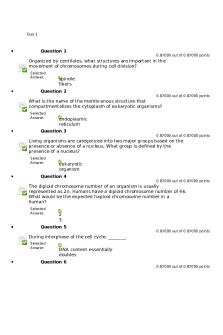Quiz 4 Answer Key Revised PDF

| Title | Quiz 4 Answer Key Revised |
|---|---|
| Course | Biomaterials and Medical Devices |
| Institution | The University of Texas at Dallas |
| Pages | 2 |
| File Size | 170 KB |
| File Type | |
| Total Downloads | 71 |
| Total Views | 194 |
Summary
Quiz 4 Answers, Professor: Dr. Danieli Rodriguez...
Description
Biomaterials and Medical Devices BMEN 4360 Fall 2016
QUIZ ANSWER KEY#4 (SO: k) Name(s): Date: P1 (15 points). What is the effect of heating treatments in metals and their alloys? In what phase(s) of a metal/device manufacturing process is heating treatment performed? Heating treatments effect metals and their alloys by changing their microstructures, which in turn alters the metal’s mechanical properties. Heating treatments can be performed when the metal is in bulk form (per requirements of the industry ordering the material) or at the stage when the device is close to the final geometry. Review slides from Week 6 set 1 pgs. 127-132. P2 (10 points). Compare cold and hot work Hot work causes changes in the metal’s microstructure by subjecting it to mechanical stress and temperatures above its recrystallization temperature. This process creates new undeformed grains from deformed grains. An examples is hot rolling. Cold work causes changes in the metal’s microstructure through mechanical stress. The metal is subjected to mechanical stresses and temperatures below its recrystallization temperature, which will cause plastic deformation of the grains. This process creates deformed grains from mechanical stress. Review slides from Week 6 set 1 pgs. 132-133. P3 (10 points). Describe the martensitic phase Martensitic phase occurs when the metal is heated then cooled rapidly. This diffusionless process causes the microstructure to become distorted due to Carbon and other elements trapped within the crystalline structure which results in a hard metal. P4 (10 points). What is the effect of quenching and annealing in the metal microstructure and consequently on mechanical performance? Quenching refers to rapid cooling of a material (can be immersed in air, a liquid bath, or a vacuum). This process causes residual stresses and can lead to cracks within the material consequently making the metal more susceptible to failure. Annealing is the heating and slow cooling of a metal to produce a refined microstructure. This process improves mechanical performance by improving machinability and enhancing the metal’s properties. 1
Biomaterials and Medical Devices BMEN 4360 Fall 2016
Review slides from Week 6 set 1 pgs. 137-138. P5 (15 points). Describe the mechanisms leading to metal oxide breakage. Fretting, micromotion, scratching, and articulation are mechanisms that can lead to metal oxide breakage. Remember that the oxide layer has the ability to repassivate and reform given the ideal conditions are present at the electrode/electrolyte interface. Review slides from Week 6 set 1 pg. 143. P6 (40 points). Compare the phase diagrams below for the Cu-Ni and Cu-Ag alloy systems. Based on solubility and type of phase diagrams what can you conclude about these two alloys? How will the microstructure of each alloy look? Can you identify points in the curve(s) for limit of solubility? Can you identify a eutectic point? What phase would you obtain at a temperature of 1000 0C and 50/50 composition (%) for each alloy?
Limits of Solubility Eutectic point
One phase Indistinguishable microstructure Solid phase at 10000C and 50/50 composition (%)
Multiple phase Multiple phase microstructure Liquid phase at 1000 0C and 50/50 composition (%)
2...
Similar Free PDFs

Quiz 4 Answer Key Revised
- 2 Pages

WK 4 - Unit 4 Quiz answer key
- 3 Pages

Answer Key Revised SOC 101
- 94 Pages

Answer Key Quiz #11 - quiz
- 4 Pages

Answer Key Quiz #7 - quiz
- 2 Pages

Quiz5 - Quiz Answer Key
- 7 Pages

Quiz 1 Answer Key
- 5 Pages

Chemlab QUIZ Answer KEY
- 2 Pages

Quiz 1 Answer Key
- 3 Pages

Photosynthesis Quiz answer key
- 2 Pages

Short Answer Quiz 4 - Quiz
- 2 Pages

Answer Key for Assignment 4
- 2 Pages

Workshop 4 - detailed answer key
- 4 Pages
Popular Institutions
- Tinajero National High School - Annex
- Politeknik Caltex Riau
- Yokohama City University
- SGT University
- University of Al-Qadisiyah
- Divine Word College of Vigan
- Techniek College Rotterdam
- Universidade de Santiago
- Universiti Teknologi MARA Cawangan Johor Kampus Pasir Gudang
- Poltekkes Kemenkes Yogyakarta
- Baguio City National High School
- Colegio san marcos
- preparatoria uno
- Centro de Bachillerato Tecnológico Industrial y de Servicios No. 107
- Dalian Maritime University
- Quang Trung Secondary School
- Colegio Tecnológico en Informática
- Corporación Regional de Educación Superior
- Grupo CEDVA
- Dar Al Uloom University
- Centro de Estudios Preuniversitarios de la Universidad Nacional de Ingeniería
- 上智大学
- Aakash International School, Nuna Majara
- San Felipe Neri Catholic School
- Kang Chiao International School - New Taipei City
- Misamis Occidental National High School
- Institución Educativa Escuela Normal Juan Ladrilleros
- Kolehiyo ng Pantukan
- Batanes State College
- Instituto Continental
- Sekolah Menengah Kejuruan Kesehatan Kaltara (Tarakan)
- Colegio de La Inmaculada Concepcion - Cebu


